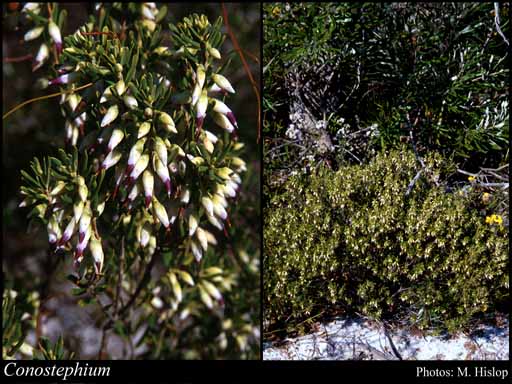- Reference
- Enum.Pl. 76 (1837)
- Name Status
- Current

Scientific Description
Family Epacridaceae.
Habit and leaf form. Small shrubs; evergreen; leptocaul, or pachycaul. Helophytic to xerophytic. Leaves small to medium-sized; alternate; spiral, or four-ranked; ‘herbaceous’, or leathery; imbricate, or not imbricate; petiolate to sessile; non-sheathing; simple. Leaf blades entire; flat, or rolled; palmately veined; cross-venulate, or without cross-venules. Leaves without stipules. Leaf blade margins flat, or revolute. Stem anatomy. Nodes unilacunar. Secondary thickening developing from a conventional cambial ring.
Reproductive type, pollination. Fertile flowers hermaphrodite. Unisexual flowers absent. Plants hermaphrodite. Entomophilous, or ornithophilous. Pollination mechanism unspecialized.
Inflorescence and flower features. Flowers solitary; axillary; pedicellate (usually pendulous); bracteate; bracteolate (bracteoles appressed to the sepals); small to medium-sized; fragrant, or odourless; regular; 5 merous; cyclic; tetracyclic. Free hypanthium absent. Hypogynous disk present, or absent; intrastaminal; when present, of separate members (5 distinct scales). Perianth with distinct calyx and corolla; 10; 2 -whorled; isomerous. Calyx 5; 1 -whorled; polysepalous; scarious; imbricate; exceeding the corolla, or more or less equalling the corolla (or corolla scarcely protruding from the calyx); regular; persistent (enclosing the mature fruit). Sepals broadly to very broadly ovate. Corolla 5; 1 -whorled; gamopetalous; lobed (lobes erect, acute). Corolla lobes markedly shorter than the tube (very small, erect, acute). Corolla valvate; tube more or less conical in upper part or cylindrical for its whole length; regular; hairy adaxially (towards the throat but without scales or tufts of hairs in the lower half; lobes glabrous inside and out), or glabrous adaxially; red to purple, or white and purple, or pink; persistent, or deciduous. Androecium 5. Androecial members adnate (to the corolla); all equal; free of one another; 1 -whorled. Androecium exclusively of fertile stamens. Stamens 5. Staminal insertion midway down the corolla tube, or near the base of the corolla tube (at the base of or below the cone of the corolla). Stamens remaining included; isomerous with the perianth; oppositisepalous; all alternating with the corolla members. Filaments glabrous; short. Anthers all alike (elongated, usually deeply divided into 2 lobes joined by a short connective); basifixed, or adnate; becoming inverted during development, their morphological bases ostensibly apical in the mature stamens; non-versatile; dehiscing via longitudinal slits (by two slits); finally introrse (inverting during development); bisporangiate; unappendaged. Pollen shed as single grains; without viscin strands. Gynoecium 5 carpelled. The pistil 5 celled. Gynoecium syncarpous; eu-syncarpous; superior. Ovary plurilocular; 5 locular. Gynoecium stylate. Styles 1; long, slender; attenuate from the ovary; apical; becoming exserted. Stigmas 1; small, truncate, or clavate, or capitate. Placentation apical. Ovules 1 per locule; pendulous; non-arillate; anatropous.
Fruit and seed features. Fruit non-fleshy; indehiscent; a drupe. The drupes with one stone. Fruit 5 celled. Endocarp hard. Fruit 5 seeded (or fewer by abortion). Seeds endospermic. Endosperm oily. Seeds wingless. Embryo well differentiated. Cotyledons 2. Embryo straight. Seedling. Germination phanerocotylar.
Physiology, biochemistry. Aluminium accumulation not found. Photosynthetic pathway: C3.
Geography, cytology, number of species. Native of Australia. Endemic to Australia. Australian states and territories: Western Australia. South-West Botanical Province.
Additional characters Prophylls numerous.